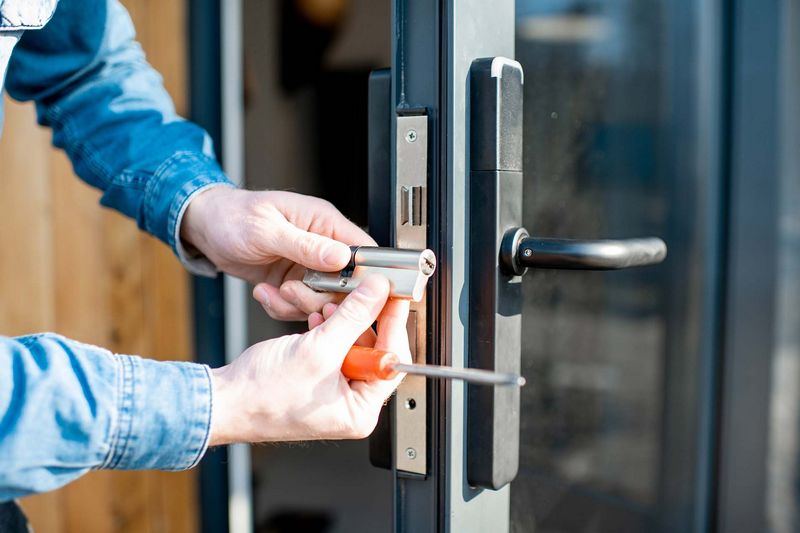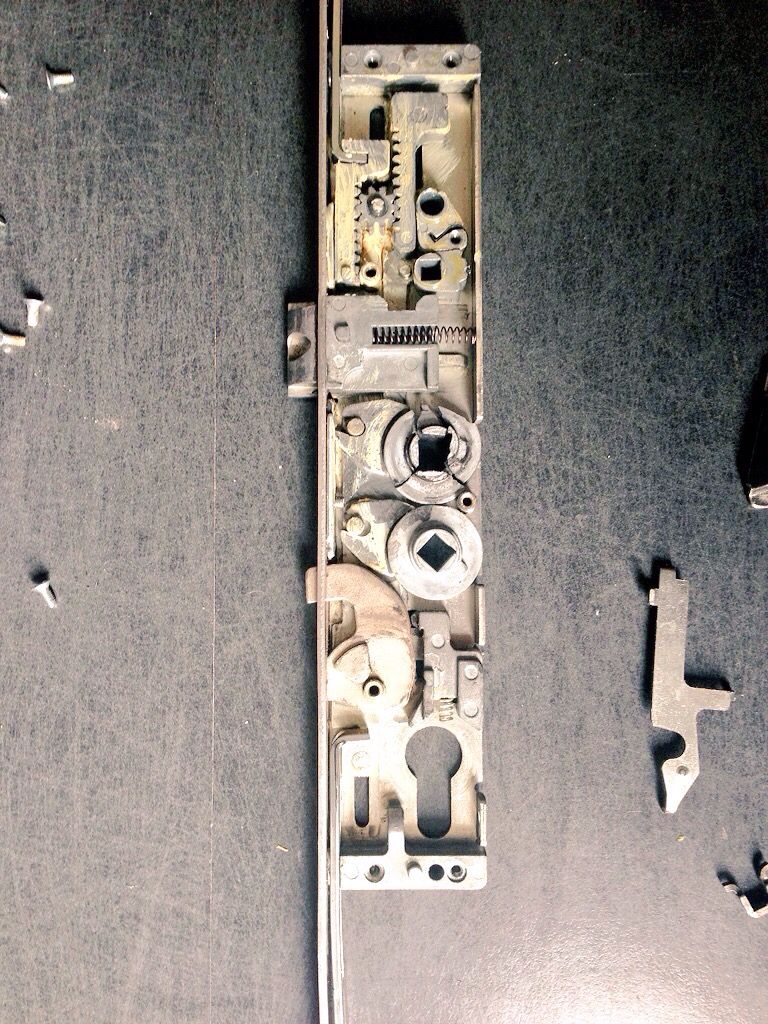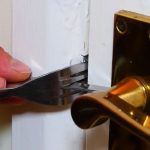
UPVC Door Lock Mechanism Sticking – Why This Happens
Have you noticed that your UPVC door lock mechanism is sticking? If you’re experiencing this issue, you’re not alone. Many homeowners encounter problems with their UPVC door locks, with sticking being one of the most common issues. In this article, we will explore the reasons why the UPVC door lock mechanism may be sticking and provide some insights on how to address the problem.
The first reason why your UPVC door lock mechanism may be sticking is due to a build-up of dirt and debris. Over time, dirt, dust, and other particles can accumulate in the lock mechanism, preventing it from operating smoothly. This build-up can be caused by external factors such as weather conditions or simply everyday use. If you notice that your UPVC door lock is sticking, it is worth checking for any visible dirt or debris and removing it using a soft brush or vacuum cleaner.
Another common reason for a sticking UPVC door lock mechanism is poor lubrication. Like any mechanical part, the lock mechanism requires regular lubrication to ensure smooth operation. If the lock mechanism is not properly lubricated, the moving parts can become stiff and difficult to operate. To resolve this issue, it is recommended to use a silicone-based lubricant specifically designed for UPVC door locks. Apply a small amount of lubricant to the moving parts of the lock mechanism, such as the latch and bolts, and operate the lock a few times to distribute the lubricant evenly.
Lastly, a sticking UPVC door lock mechanism could be an indication of an underlying problem with the lock itself. Over time, the internal components of the lock can wear out or become misaligned, leading to difficulty in operation. In such cases, it is best to seek professional assistance from a locksmith or UPVC door specialist. They will be able to diagnose the issue and recommend the appropriate solution, which may involve repairing or replacing the lock mechanism.
In conclusion, a sticking UPVC door lock mechanism can be caused by a variety of factors including dirt and debris build-up, poor lubrication, or an underlying problem with the lock. By understanding these reasons and taking appropriate action, you can ensure that your UPVC door lock operates smoothly and securely.
Common Issues with UPVC Door Lock Mechanism
Sticking is a common problem that can occur with UPVC door lock mechanisms. This happens when the lock mechanism becomes difficult to operate and does not open or close smoothly. There are several reasons why this issue may arise.
One possible cause of sticking in the UPVC door lock mechanism is dirt and debris accumulation. Over time, dust, dirt, and other particles can build up inside the lock mechanism, causing it to become sticky and difficult to operate. Regular cleaning and lubrication can help prevent this issue.
Another reason for sticking in the UPVC door lock mechanism is misalignment. If the lock mechanism is not properly aligned with the door frame, it can put excessive pressure on the mechanism, causing it to stick. Proper installation and adjustment can help resolve this issue.
Age and wear can also contribute to sticking in the UPVC door lock mechanism. Over time, the parts of the lock mechanism can wear down or become damaged, resulting in a decrease in performance and an increased likelihood of sticking. Regular maintenance and replacement of worn-out parts can help prevent this issue.
In summary, sticking in the UPVC door lock mechanism can occur due to dirt and debris accumulation, misalignment, and age and wear. Regular cleaning, proper installation, and maintenance can help prevent and resolve these common issues.
Inadequate Lubrication Causes Sticking
One of the common reasons why UPVC door locks stick is due to inadequate lubrication. Locks need proper lubrication to function smoothly, but if this is neglected, the mechanism can start sticking.
UPVC doors, like any other doors, have a complex locking mechanism that relies on various moving parts to work together seamlessly. Over time, these moving parts can become dry or clogged with dirt and debris, leading to friction and difficulty in operation. If the lock is not adequately lubricated, it can cause the mechanism to stick.
When enough lubrication is absent, the key may become difficult to insert or turn, or the handle may not fully engage or disengage the lock. This can be frustrating and inconvenient, especially when you’re in a hurry to enter or exit your property.
To prevent sticking and ensure the smooth operation of your UPVC door lock, it is essential to regularly lubricate the mechanism. Using a suitable lubricant, such as a silicone-based lubricant or a graphite powder, can help reduce friction and keep the moving parts of the lock functioning properly.
Regular maintenance and lubrication can extend the lifespan of your UPVC door lock and minimize the chances of it sticking. It is recommended to consult the manufacturer’s guidelines or seek professional advice on the appropriate lubricant and maintenance routine for your specific lock model.
In summary, inadequate lubrication is one of the reasons why UPVC door locks may stick. Regular lubrication can prevent this issue and ensure the smooth functioning of the lock mechanism.
Buildup of Dirt and Debris Hampers Movement
One common reason for a UPVC door lock mechanism sticking is the buildup of dirt and debris. Over time, dust, dirt, and other small particles can accumulate in the locking mechanism, causing it to become sticky and difficult to operate.
When the lock mechanism becomes dirty, it becomes harder for the key or lever to smoothly engage with the internal components of the lock. This can cause the lock to stick, making it difficult to open or close the door.
The accumulation of dirt and debris in the lock mechanism can happen for a few reasons. One reason is the lack of regular cleaning and maintenance. If the lock is not cleaned regularly, dirt can slowly build up and hinder the movement of the lock.
Another reason is environmental factors. Dust and dirt particles can find their way into the lock mechanism through small gaps around the door or via air circulation. This is especially true if the door is situated in a dusty or dirty environment.
To prevent the buildup of dirt and debris in the lock mechanism, regular cleaning and maintenance are essential. This can be done by using a soft brush or cloth to remove any visible dirt or debris from the lock. It is also important to lubricate the locking mechanism with a silicone-based lubricant to ensure smooth movement.
In conclusion, the buildup of dirt and debris in the UPVC door lock mechanism is a common cause of sticking. Regular cleaning and maintenance can help prevent this issue and ensure the smooth operation of the lock.
Warped Frame Affects Locking Mechanism
Another reason why the UPVC door lock mechanism may be sticking is due to a warped door frame. When the door frame becomes warped, it can affect the alignment of the lock and make it difficult to open and close the door.
A warped frame can occur over time due to various factors such as changes in weather conditions, improper installation, or simply wear and tear. When the door frame becomes warped, it puts pressure on the lock mechanism, causing it to stick.
It is important to address a warped frame as soon as possible, as the longer it is left untreated, the more damage can occur to the lock and the door. In some cases, a warped frame may need to be repaired or replaced to ensure the proper functioning of the lock.
If you notice that your UPVC door lock mechanism is sticking and suspect that a warped frame may be the cause, it is recommended to consult a professional locksmith or door repair specialist. They will be able to assess the situation and provide the necessary solutions to fix the issue and prevent further damage.
| 1. Misaligned door frame |
| 2. Warped door frame |
| 3. Faulty lock mechanism |
| 4. Build-up of dirt and debris |
| 5. Lack of lubrication |
Impact of Temperature and Weather on UPVC Doors
One of the reasons why the UPVC door lock mechanism may sometimes stick is because of the impact of temperature and weather on the door itself.
Temperature changes can cause the UPVC door to expand or contract. In hot weather, the door can expand and become slightly larger than its frame, causing the lock mechanism to feel tighter and harder to operate. On the other hand, in cold weather, the door can contract and become smaller than the frame, making it more difficult for the lock to properly engage.
Weather conditions, such as heavy rain or extreme humidity, can also affect the UPVC door. Moisture can get into the mechanism, causing it to become sticky or rusted over time. This can make it harder for the lock to turn smoothly.
To overcome these issues, it is important to ensure that the UPVC door is properly installed and aligned. Proper insulation and sealing can also help minimize the impact of temperature and weather on the door. Regular maintenance, such as lubricating the lock mechanism and keeping it clean, can also prevent sticking and ensure smooth operation.
In conclusion, understanding the impact of temperature and weather on UPVC doors can help explain why the door lock mechanism sometimes sticks. By taking proper measures to address these issues, such as proper installation, insulation, and regular maintenance, it is possible to prevent sticking and ensure smooth operation of the lock mechanism.
Expansion and Contraction of UPVC Doors Due to Heat
One of the reasons why the mechanism of a UPVC door lock may start sticking is due to the expansion and contraction of the door itself caused by changes in temperature.
UPVC doors are made of a type of plastic called unplasticized polyvinyl chloride (UPVC). This material is known for its thermal properties, which means that it expands when heated and contracts when cooled.
When a UPVC door is exposed to heat, such as direct sunlight or a warm room, it can expand slightly. This expansion may not be visible to the naked eye, but it can affect the overall alignment and fit of the door.
As the door expands, the lock mechanism may start to stick or become more difficult to operate smoothly. This happens because the expansion puts pressure on the internal components of the lock, causing them to become misaligned or jammed.
Similarly, when the UPVC door cools down, it contracts and may cause the lock mechanism to become loose or unstable. This can also result in sticking or difficulties in operating the lock.
To prevent these issues, it is important to ensure that the UPVC door is properly installed and fitted. Proper alignment and adjustments can help minimize the effects of expansion and contraction caused by heat. Regular maintenance, such as lubricating the lock mechanism, can also help keep it running smoothly despite temperature changes.
Moisture and Rainwater Damage the Lock Mechanism

One of the main reasons why the UPVC door lock mechanism may be sticking is due to moisture and rainwater damage. UPVC doors are designed to be weather-resistant, but over time, they can still be affected by water.
When rainwater seeps into the lock mechanism, it can cause rust and corrosion. This can lead to the lock becoming stiff and difficult to operate. Additionally, moisture can also cause the internal components of the lock to swell or warp, which further exacerbates the sticking problem.
It is important to note that moisture and rainwater damage may not be immediately visible. The damage can occur slowly over time, causing gradual wear and tear on the lock mechanism. If you notice that your UPVC door lock is sticking, it is advisable to check for signs of water damage.
To prevent moisture and rainwater damage, it is recommended to regularly inspect and maintain your UPVC door. Ensure that the door frame is properly sealed, and that there are no gaps or cracks where water can enter. You can also apply a silicone spray or lubricant to the lock mechanism to protect it from moisture.
In conclusion, moisture and rainwater damage can cause the UPVC door lock mechanism to stick. Taking preventive measures and addressing water damage promptly can help prolong the lifespan of your lock mechanism and ensure smooth operation of your UPVC door.
Frost and Freezing Temperatures Cause Sticking
One of the reasons why UPVC door lock mechanism sticking happens is due to frost and freezing temperatures. When the weather gets cold, moisture in the air can accumulate on the door and its components, including the lock mechanism. As this moisture freezes, it can cause the mechanism to become stiff and difficult to operate.
Additionally, freezing temperatures can cause the UPVC material itself to contract and become less flexible. This contraction can also contribute to the sticking of the lock mechanism, especially if there is already moisture present.
To prevent the lock mechanism from sticking in frosty conditions, it is important to regularly clean and lubricate the door and its components. This can help create a protective barrier against moisture and keep the mechanism operating smoothly. Applying a silicone-based lubricant to the lock and other moving parts can also help reduce friction and prevent sticking.
In extreme cases, when the lock mechanism is completely stuck due to frost and freezing temperatures, it may be necessary to use a gentle heat source, such as a hairdryer, to thaw the mechanism. However, caution should be exercised to avoid overheating and causing damage to the door or its components.
Overall, being aware of the impact of frost and freezing temperatures on UPVC door lock mechanisms can help homeowners take preventative measures and ensure the smooth operation of their doors, even in cold weather conditions.
Problems Arising from Poor Installation or Maintenance
When it comes to uPVC door locks, proper installation and regular maintenance are crucial for their smooth operation. If the mechanism is not installed correctly or if it is not properly maintained, it can lead to various problems, including sticking.
One of the main reasons why uPVC door locks may stick is due to poor installation. If the lock is not aligned properly or if it is not fitted securely, it can cause the mechanism to become misaligned and stick. Additionally, if the lock is not installed with the correct measurements and specifications, it can put unnecessary strain on the mechanism, leading to sticking issues.
Another common problem that can arise from poor installation or maintenance is the accumulation of dirt and debris. Over time, dust, dirt, and other particles can build up in the lock mechanism, causing it to become sticky and difficult to operate. Regular cleaning and maintenance of the lock can help prevent this issue from occurring.
In some cases, poor lubrication can also cause uPVC door locks to stick. If the lock mechanism is not properly lubricated, the moving parts can become dry and friction can occur, resulting in sticking. It is important to use the recommended lubricant and follow the manufacturer’s instructions for lubrication to prevent this problem.
In conclusion, poor installation or maintenance can lead to uPVC door lock mechanisms sticking. By ensuring proper installation, regular maintenance, and keeping the lock mechanism clean and properly lubricated, you can help prevent sticking issues and ensure the smooth operation of your uPVC door lock.
Incorrect Alignment Affects Lock Performance
An important factor that can contribute to the sticking of a uPVC door lock mechanism is incorrect alignment. When the door and frame are not properly aligned, the lock may not catch and engage as intended, resulting in difficulties when trying to lock or unlock the door.
This misalignment can happen for a variety of reasons. It could be due to settling of the building, changes in temperature and humidity, or even a faulty installation. Regardless of the specific cause, the result is the same – the lock mechanism won’t function properly, leading to sticking issues.
To understand why misalignment affects the lock performance, it is important to consider how the uPVC door lock mechanism works. The lock consists of various components, including the latch, the gearbox, and the handle. When the handle is turned, it activates the gearbox which then moves the latch, allowing the door to be opened or secured.
If the door and frame are not aligned correctly, this sequence of events may be disrupted. For example, if the latch and striker plate do not line up, the latch may not be able to fully extend or retract, causing it to stick. This misalignment can also put unnecessary strain on the gearbox, leading to wear and tear over time.
It is important to address incorrect alignment issues promptly to avoid further complications with the door lock mechanism. Adjustments may need to be made to the door or frame to ensure proper alignment and smooth operation of the lock. This may involve tightening screws, realigning the strike plate, or even replacing certain components if necessary.
If you are experiencing sticking issues with your uPVC door lock mechanism, it is recommended to consult a professional locksmith or door specialist. They will be able to assess the situation and provide the necessary repairs or adjustments to restore proper functionality to your lock.
| Key Takeaways: |
| – Incorrect alignment of the uPVC door and frame can cause sticking issues with the lock mechanism. |
| – Misalignment may be caused by settling, temperature changes, or faulty installation. |
| – Misalignment disrupts the proper functioning of the lock’s latch and gearbox. |
| – Promptly addressing alignment issues can prevent further complications and damage to the lock. |
| – Consulting a professional locksmith or door specialist is recommended for proper repairs and adjustments. |
Loose or Worn Components Lead to Sticking
The reason why a UPVC door lock mechanism sticks is often due to loose or worn components. Over time, the constant usage and exposure to weather elements can cause the internal parts of the lock mechanism to wear down or become loose, resulting in difficulty when operating the door.
When the components of the lock mechanism become loose, they may not align properly, causing resistance when trying to lock or unlock the door. This misalignment can prevent the lock from fully engaging or disengaging, leading to sticking.
In addition, worn components, such as the cylinder or the gearbox, can also contribute to sticking. The cylinder is the part of the lock that the key goes into, and over time, it can become worn or damaged. This wear and tear can affect the smooth movement of the key, resulting in sticking when trying to unlock or lock the door.
Similarly, the gearbox, which is responsible for transferring the motion of the key to the locking mechanism, can also wear down or become damaged. When this happens, the movement of the key may not be effectively transmitted to the lock, causing the door to stick.
To prevent sticking due to loose or worn components, regular maintenance and inspection of the UPVC door lock mechanism are essential. This includes tightening any loose screws or bolts, lubricating moving parts, and replacing any worn or damaged components.
In conclusion, loose or worn components are a common reason why a UPVC door lock mechanism may stick. Regular maintenance and timely replacement of worn parts can help ensure the smooth operation of the lock and prevent sticking.
Lack of Regular Cleaning and Maintenance
One of the main reasons why the UPVC door lock mechanism can stick is a lack of regular cleaning and maintenance. Over time, dust, dirt, and debris can accumulate in and around the lock, causing it to become stiff and difficult to operate.
When this happens, the mechanism may not align properly, leading to issues such as sticking, jamming, or even complete failure of the lock.
To prevent this from happening, it is important to regularly clean and maintain your UPVC door lock. This can be done by using a soft cloth or brush to remove any dirt or debris from the lock, as well as applying a small amount of lubricant to keep the mechanism running smoothly.
Regular cleaning and maintenance not only help prevent the lock from sticking but also extend its lifespan and ensure the security of your door. By taking the time to clean and maintain your UPVC door lock, you can avoid the inconvenience and potential cost of having to repair or replace it in the future.
Q&A:
Why does my UPVC door lock mechanism stick?
There can be several reasons why your UPVC door lock mechanism is sticking. It could be due to dirt or debris getting trapped in the lock, improper alignment of the door and frame, a faulty lock mechanism, or the need for lubrication. It is recommended to clean the lock, check the alignment, and lubricate the mechanism to see if it resolves the issue.
How can I clean the UPVC door lock mechanism?
To clean the UPVC door lock mechanism, you can start by using a vacuum cleaner or compressed air to remove any loose dirt or debris from the lock. Then, you can use a cotton swab or a toothbrush dipped in soapy water to gently scrub the mechanism. Make sure to dry it thoroughly before attempting to use the lock again.
What should I do if the UPVC door lock mechanism is misaligned?
If the UPVC door lock mechanism is misaligned, you can try adjusting the hinges of the door to see if it solves the problem. You can also check if the door is sitting properly in the frame and adjust it if necessary. If the lock is still sticking after realigning the door, it is advisable to consult a professional locksmith or a door repair specialist for further assistance.
Can I lubricate the UPVC door lock mechanism?
Yes, lubricating the UPVC door lock mechanism can often help resolve sticking issues. You can use a silicone-based lubricant or a graphite powder to lubricate the lock. Apply the lubricant to the moving parts of the mechanism, such as the latch and the bolt. Be careful not to use oil-based lubricants, as they can attract dirt and make the problem worse.



